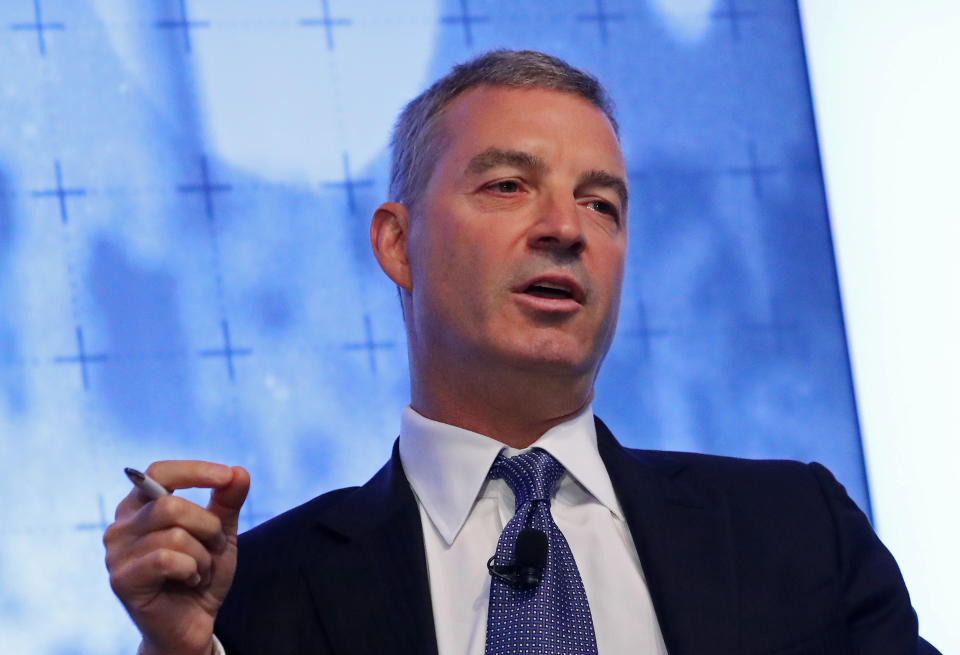The biggest hedge funds have been piling into bank stocks

The biggest hedge funds recently revealed the stocks they bought and sold after the presidential election.
The financial sector gained popularity, seeing the largest inflows during the fourth quarter, according to a new report from FactSet that tracks the 50 biggest hedge funds.
Bank of America (BAC) was the top stock pick among the financials.
“The top 50 hedge funds bought $3.5 billion worth of stock in the Financials group during the fourth quarter, which represented the largest aggregate purchase of all 11 GICS sectors,” the report said.
It continued: “Bank of America was the top buy in the group, with funds adding $1.5 billion worth of the bank’s stock. It was also the second largest purchase overall in Q4. Within the sector, the buys were widespread, with funds adding over $1 billion to each of the Diversified Financials, Insurance, and Banks industry groups. S&P Global and Marsh & McLennan were the largest hedge fund purchases in the Financials sector, after Bank of America.”
Financial stocks rallied following the election of Donald J. Trump on expectations for corporate tax cuts and deregulation.

Daniel Loeb’s Third Point LLC’s made a nearly $1 billion bet on financials. Loeb’s biggest buys included JPMorgan Chase (JPM) and Bank of America. Loeb snapped up 5.25 million shares of JPMorgan, a position valued at $453 million at the end of the fourth quarter. JPMorgan was Third Point’s fifth largest stock holding at the end of 2016. Loeb bought 7.5 million shares of Bank of America, a position valued at $386.7 million at the end of the quarter. He also initiated a new position in Goldman Sachs (GS) valued at just over $95 million at the end of 2016.
In Third Point’s fourth quarter letter dated Feb. 1, Loeb explained that his fund increased its exposure to financial stocks right after the election of Donald J. Trump. He noted that his fund continued to increase its exposure to financials in January.
“On November 8th, our financials portfolio was 4.4% of the fund. One day later, it was 6.0%; one week later, 10.5%; one month later, 11.8%,” Loeb wrote, adding, “These figures actually understate the magnitude of the shift, however, as we reallocated half our initial holdings from high‐multiple, FCF businesses in Payments, Ratings, and P&C (which traditionally outperform during periods of deflation), to more traditional reflationary exposures in Banks, Brokers, and, geographically, in Japan. This was a calculated top‐down shift and was expressed in stocks where we had a fundamental view. Our conviction has only increased since we first initiated these investments; we have added exposure to each of the names in 2017.”
What’s more, Loeb’s bullishness on financials doesn’t have to do with corporate tax cuts or deregulation. Instead, it’s focused on interest rates.

“Some believe the rally in financials has been driven by expectations of tax cuts, or the potential repeal of the Volcker Rule, or reduced compliance costs, or more relaxed capital regulations. Any and all of these things would bring material, additional upside to bank stocks. But our focus is different. The pendulum in monetary policy has begun to shift away from the past decade of extraordinary easing just as the pendulum in fiscal policy has begun to shift away from austerity and its limiting factors. The U.S. elections served as a marker for these policy shifts which, in our view, are bullish for rate‐sensitive financials,” Loeb wrote.
Julian Robertson’s Tiger Management bought Bank of America and Citigroup. “Tiger cub” Philippe Laffont’s tech-focused hedge fund Coatue Management snapped up new positions in Bank of America and JPMorgan Chase. Coatue also bought 13.2 million shares of The Financial Sector SPDR ETF (XLF). Another “Tiger Cub,” Blue Ridge Capital, led by John Griffin, bought Bank of America, Wells Fargo (WFC), and Citigroup. Blue Ridge increased its Citigroup (C), adding 366,200 more shares, bringing its total stake of just over 5.56 million shares.
U.K.-based Lansdowne Partners and Egerton Capital also made large purchases of Bank of America shares.
Hedge funds of a certain size are required to disclose their long equity holdings in regulatory filings known as 13-Fs. These filings come out 45 days after the end of each quarter. They do not include short bets or bets on currencies, bonds, and commodities. It’s possible that the funds could have sold or added to their positions during the past 45 days.
—
Julia La Roche is a finance reporter at Yahoo Finance. Follow her on Twitter.
Read more:

